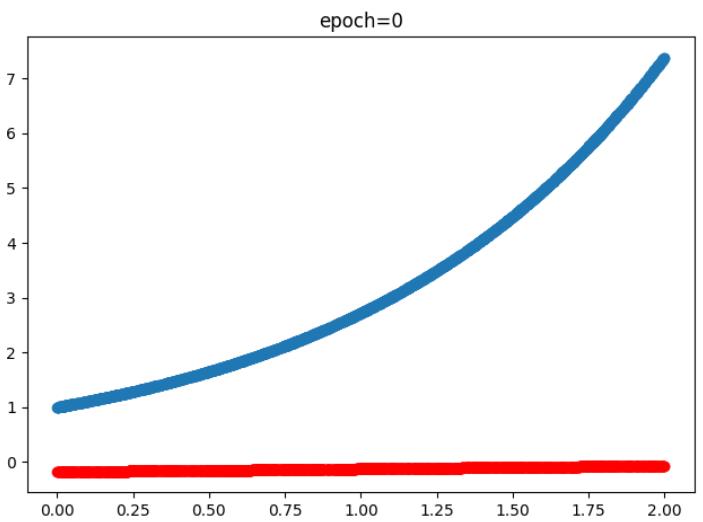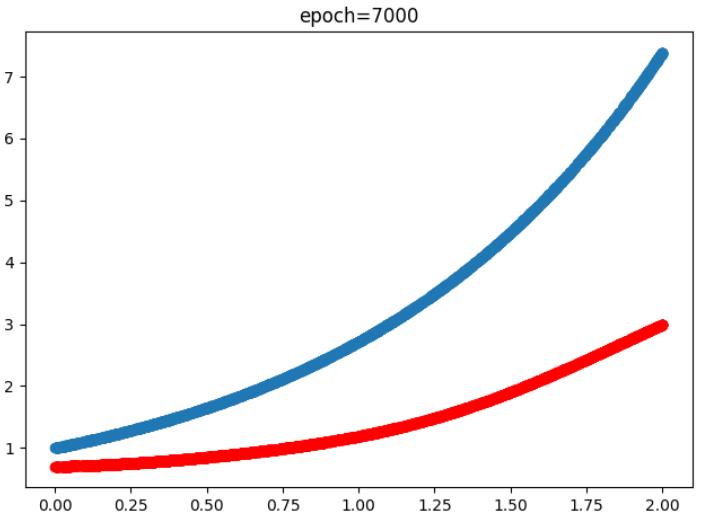PINN学习与实验
Posted _刘文凯_
tags:
篇首语:本文由小常识网(cha138.com)小编为大家整理,主要介绍了PINN学习与实验相关的知识,希望对你有一定的参考价值。
目录
今天第一天接触PINN,用深度学习的方法求解PDE,看来是非常不错的方法。做了一个简单易懂的例子,这个例子非常适合初学者。做了一个小demo, 大家可以参考参考
所用工具
使用了python和pytorch进行实现
python3.6
toch1.10
数学方程
使用一个最简单的常微分方程:
f
′
(
x
)
=
f
(
x
)
(
1
)
f
(
0
)
=
1
(
2
)
f'(x) = f(x) \\hspace2cm(1) \\\\ f(0) = 1 \\hspace2.6cm(2)
f′(x)=f(x)(1)f(0)=1(2)
这个微分方程其实就是:
f
(
x
)
=
e
x
(
3
)
f(x)=e^x \\hspace2.45cm(3)
f(x)=ex(3)
模型搭建
核心-使用最简单的全连接层:
class Net(nn.Module):
def __init__(self, NL, NN): # NL n个l(线性,全连接)隐藏层, NN 输入数据的维数,
# NL是有多少层隐藏层
# NN是每层的神经元数量
super(Net, self).__init__()
self.input_layer = nn.Linear(1, NN)
self.hidden_layer = nn.linear(NN,int(NN/2)) ## 原文这里用NN,我这里用的下采样,经过实验验证,“等采样”更优。更多情况有待我实验验证。
self.output_layer = nn.Linear(int(NN/2), 1)
def forward(self, x):
out = torch.tanh(self.input_layer(x))
out = torch.tanh(self.hidden_layer(out))
out_final = self.output_layer(out)
return out_final
偏微分方程定义,也就是公式(1):
def ode_01(x,net):
y=net(x)
y_x = autograd.grad(y, x,grad_outputs=torch.ones_like(net(x)),create_graph=True)[0]
return y-y_x # y-y' = 0
所有实现代码
一下代码复制粘贴,可直接运行:
import torch
import torch.nn as nn
import numpy as np
import matplotlib.pyplot as plt
from torch import autograd
"""
用神经网络模拟微分方程,f(x)'=f(x),初始条件f(0) = 1
"""
class Net(nn.Module):
def __init__(self, NL, NN): # NL n个l(线性,全连接)隐藏层, NN 输入数据的维数,
# NL是有多少层隐藏层
# NN是每层的神经元数量
super(Net, self).__init__()
self.input_layer = nn.Linear(1, NN)
self.hidden_layer = nn.Linear(NN,int(NN/2)) ## 原文这里用NN,我这里用的下采样,经过实验验证,“等采样”更优。更多情况有待我实验验证。
self.output_layer = nn.Linear(int(NN/2), 1)
def forward(self, x):
out = torch.tanh(self.input_layer(x))
out = torch.tanh(self.hidden_layer(out))
out_final = self.output_layer(out)
return out_final
net=Net(4,20) # 4层 20个
mse_cost_function = torch.nn.MSELoss(reduction='mean') # Mean squared error 均方误差求
optimizer = torch.optim.Adam(net.parameters(),lr=1e-4) # 优化器
def ode_01(x,net):
y=net(x)
y_x = autograd.grad(y, x,grad_outputs=torch.ones_like(net(x)),create_graph=True)[0]
return y-y_x # y-y' = 0
# requires_grad=True).unsqueeze(-1)
plt.ion() # 动态图
iterations=200000
for epoch in range(iterations):
optimizer.zero_grad() # 梯度归0
## 求边界条件的损失函数
x_0 = torch.zeros(2000, 1)
y_0 = net(x_0)
mse_i = mse_cost_function(y_0, torch.ones(2000, 1)) # f(0) - 1 = 0
## 方程的损失函数
x_in = np.random.uniform(low=0.0, high=2.0, size=(2000, 1))
pt_x_in = autograd.Variable(torch.from_numpy(x_in).float(), requires_grad=True) # x 随机数
pt_y_colection=ode_01(pt_x_in,net)
pt_all_zeros= autograd.Variable(torch.from_numpy(np.zeros((2000,1))).float(), requires_grad=False)
mse_f=mse_cost_function(pt_y_colection, pt_all_zeros) # y-y' = 0
loss = mse_i + mse_f
loss.backward() # 反向传播
optimizer.step() # 优化下一步。This is equivalent to : theta_new = theta_old - alpha * derivative of J w.r.t theta
if epoch%1000==0:
y = torch.exp(pt_x_in) # y 真实值
y_train0 = net(pt_x_in) # y 预测值
print(epoch, "Traning Loss:", loss.data)
print(f'times epoch - loss: loss.item() - y_0: y_0')
plt.cla()
plt.scatter(pt_x_in.detach().numpy(), y.detach().numpy())
plt.scatter(pt_x_in.detach().numpy(), y_train0.detach().numpy(),c='red')
plt.pause(0.1)
结果展示
训练0次时的结果也就是没训练,蓝色是真实值、红色是预测值:

训练2000次时的结果,蓝色是真实值、红色是预测值:

训练7000次和13000时的结果,蓝色是真实值、红色是预测值:


训练20000时的结果,蓝色是真实值、红色是预测值,不过红色已经完全把蓝色覆盖了,也就是完全拟合了:

参考文献
[1]. 每天进步一点点吧. PINN学习记录.
https://blog.csdn.net/weixin_45805559/article/details/121574293
以上是关于PINN学习与实验的主要内容,如果未能解决你的问题,请参考以下文章